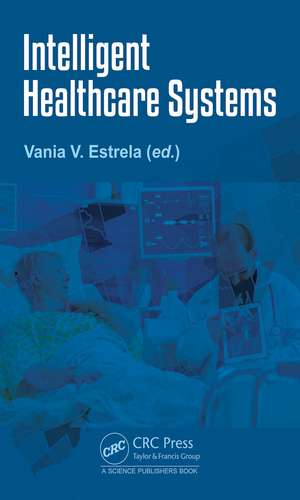Intelligent Healthcare Systems
Editat de Vania V. Estrelaen Limba Engleză Hardback – 4 aug 2023
Preț: 917.96 lei
Preț vechi: 1147.45 lei
-20% Nou
Puncte Express: 1377
Preț estimativ în valută:
175.66€ • 187.83$ • 146.45£
175.66€ • 187.83$ • 146.45£
Carte disponibilă
Livrare economică 27 martie-10 aprilie
Livrare express 13-19 martie pentru 48.46 lei
Preluare comenzi: 021 569.72.76
Specificații
ISBN-13: 9781032052724
ISBN-10: 1032052724
Pagini: 398
Ilustrații: 19 Tables, black and white; 63 Line drawings, black and white; 11 Halftones, black and white; 74 Illustrations, black and white
Dimensiuni: 156 x 234 x 26 mm
Greutate: 1.04 kg
Ediția:1
Editura: CRC Press
Colecția CRC Press
ISBN-10: 1032052724
Pagini: 398
Ilustrații: 19 Tables, black and white; 63 Line drawings, black and white; 11 Halftones, black and white; 74 Illustrations, black and white
Dimensiuni: 156 x 234 x 26 mm
Greutate: 1.04 kg
Ediția:1
Editura: CRC Press
Colecția CRC Press
Public țintă
AcademicCuprins
PART 1: INTELLIGENCE MEANINGS AND ROLES IN HEALTHCARE: INTRODUCTORY ASPECTS. Introduction to Intelligent Healthcare in a Post-Pandemic World. The Building Blocks of Health 4.0 - Internet of Things, Big Data with Cloud and Fog Computing. Internet of Medical Things (IoMT) Layers for Medical Cyber-Physical Systems. Ad Hoc Networks in Healthcare Intelligent Transportation Systems – MANETs, VANETs, and FANETs. Scale and Resolution Issues regarding Medical Images: Challenges Ahead. Some Issues regarding Content-Based Image Retrieval (CBIR) for Remote Healthcare Theradiagnosis. Blockchain Technology Enabling Better Services in the Healthcare Domain. 6G in Healthcare - Anticipating Needs and Requirements. PART 2: INFRASTRUCTURAL MEDICAL APPLICATIONS. Remote Sensing Applications in Disease Mapping and Public Health Analysis. On DICOM, HEVC and 3D Medical Image Compression for Volumetric Theragnostics. Deep Learning as a Drive Force for Better Drug Development. In-Body Devices and Sensors Communication - How Implantables, Ingestibles, and Injectables Interact with the Internet. Nanotechnology, Internet of Nano-things and Nanorobotics in Healthcare – Nano for All. Digital Twin Framework for Intelligent Healthcare Facilities through ISO/IEEE 11073. PART 3: ADVANCED APPLICATIONS USING AI. Medical Visual Theragnostic Systems Using Artificial Intelligence (AI) - Principles and Perspectives. Metaheuristics Applied to Pathology Image Analysis. Mobile Agents and Blockchain for Robust and Secure Authentication and Access Control in Healthcare Systems. Super-resolution Image Processing for Hemoglobin Quantification: A Case Study. BrATCat: Data Augmentation of MRI Scans via Image-to-Image Translation using CycleGAN Followed by Pre-Trained Model Categorization.
Notă biografică
Vania V. Estrela has a B.S. degree from Federal University of Rio de Janeiro (UFRJ) in Electrical and Computer Engineering (ECE); M.Sc. from the Technological Institute of Aeronautics (ITA), Brazil; M.Sc. degree in ECE at Northwestern University, USA; and Ph.D. in ECE from the Illinois Institute of Technology (IIT), Chicago, IL, USA. Taught at DePaul University, USA, and Universidade Estadual do Norte Fluminense (UENF), Brazil. She was visiting professor at the Polytechnic Institute of Rio de Janeiro (IPRJ)/State University of Rio de Janeiro (UERJ) in Brazil and currently working at UFF's Department of Telecommunications. Research interests include signal/image/video processing, inverse problems, computational & mathematical modeling, stochastic models, multimedia, communications, motion estimation, machine learning, and geoprocessing. She reviews several journal/magazine articles, and she is deputy editor of the Neuroscience Informatics journal (Elsevier). She is engaged in technology transfer, STEAM education, environmental issues, and digital inclusion. She is editor of several books and special issues and a member of IEEE and ACM.
Descriere
The book follows a medical cyber-physical systems' paradigm to handle the dimensionality conundrum stemming from image acquisition, image modality/resolution/representation, subspace decomposition, compressed sensing, and communications constraints.
